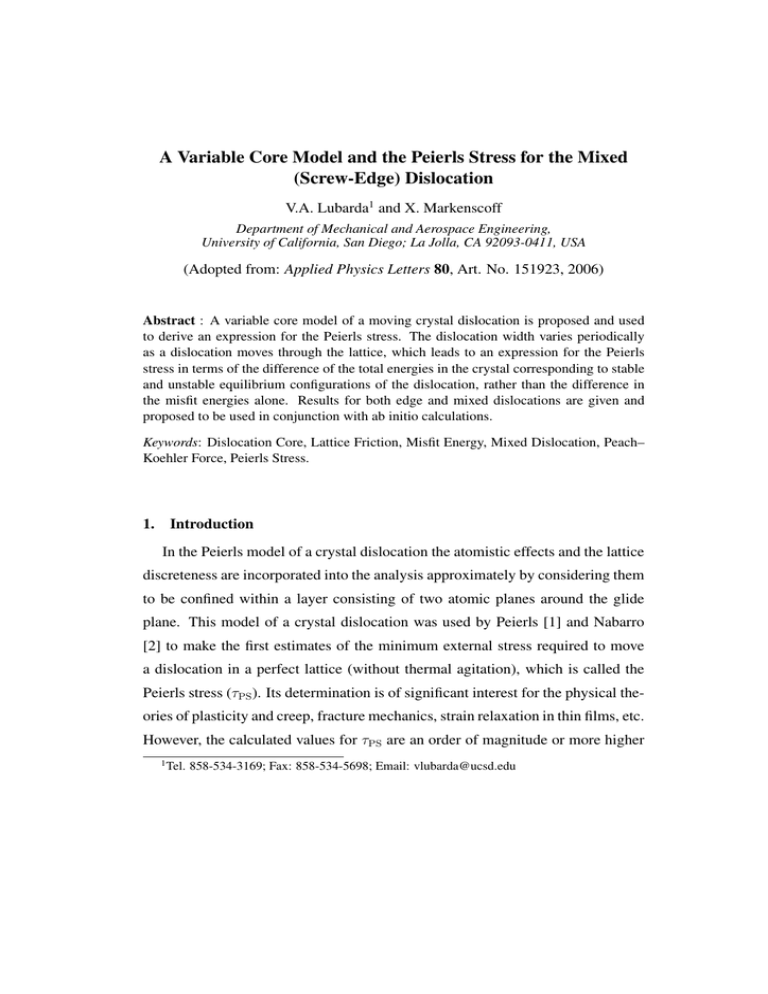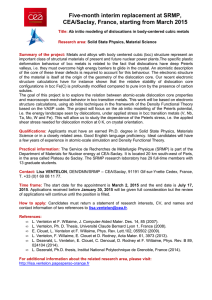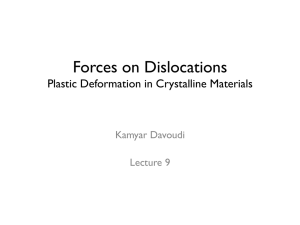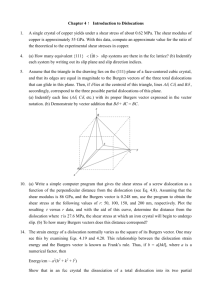A Variable Core Model and the Peierls Stress for the... (Screw-Edge) Dislocation V.A. Lubarda and X. Markenscoff
advertisement

A Variable Core Model and the Peierls Stress for the Mixed (Screw-Edge) Dislocation V.A. Lubarda1 and X. Markenscoff Department of Mechanical and Aerospace Engineering, University of California, San Diego; La Jolla, CA 92093-0411, USA (Adopted from: Applied Physics Letters 80, Art. No. 151923, 2006) Abstract : A variable core model of a moving crystal dislocation is proposed and used to derive an expression for the Peierls stress. The dislocation width varies periodically as a dislocation moves through the lattice, which leads to an expression for the Peierls stress in terms of the difference of the total energies in the crystal corresponding to stable and unstable equilibrium configurations of the dislocation, rather than the difference in the misfit energies alone. Results for both edge and mixed dislocations are given and proposed to be used in conjunction with ab initio calculations. Keywords: Dislocation Core, Lattice Friction, Misfit Energy, Mixed Dislocation, Peach– Koehler Force, Peierls Stress. 1. Introduction In the Peierls model of a crystal dislocation the atomistic effects and the lattice discreteness are incorporated into the analysis approximately by considering them to be confined within a layer consisting of two atomic planes around the glide plane. This model of a crystal dislocation was used by Peierls [1] and Nabarro [2] to make the first estimates of the minimum external stress required to move a dislocation in a perfect lattice (without thermal agitation), which is called the Peierls stress (τPS ). Its determination is of significant interest for the physical theories of plasticity and creep, fracture mechanics, strain relaxation in thin films, etc. However, the calculated values for τPS are an order of magnitude or more higher 1 Tel. 858-534-3169; Fax: 858-534-5698; Email: vlubarda@ucsd.edu than those experimentally observed, or those calculated by atomistic models, and continuing attempts were made to improve the Peierls–Nabarro model [3-11]. In the present paper we derive a new expression for the Peierls stress and the corresponding Peach–Koehler configurational force without using the concept of misfit energy, and with the assumption that the core radius/width varies periodically as the dislocation moves through the lattice. The critical configurational force is found to be Fcr = π(E∗ − Eo )/a, where E∗ − Eo is the difference between the energies of a whole stressed crystal when a dislocation is in its unstable and stable equilibrium positions, and a is the interatomic distance in the glide plane normal to the dislocation line. The result applies to both edge and mixed (screw-edge) dislocations. It is proposed that this expression be used in conjunction with ab initio calculations in a sufficiently large neighborhood surrounding the dislocation. 2. Lattice dislocation with a spread-out dislocation core An edge dislocation of a Volterra type has a singularity of order 1/x, due to ex- cessive shearing produced by suddenly applied displacement discontinuity at the center. To eliminate this singularity, a linear increase of the Burgers vector over the distance ρ is assumed (which can be viewed as a part of a disclination), where ρ is related to the extent of the dislocation core – severely deformed region around the center of the dislocation.2 This can be modeled by a continuous distribution of infinitesimal dislocations of specific Burgers vector b/ρ, or by the superposition 2 Lothe [12] used a linearly spread-out dislocation core for a screw dislocation to eliminate the divergence in the core energy, while the stresses remained singular at the core boundary. In this paper we use the wedge dislocation along the vertical axis, but only to produce a non-singular shear stress distribution along the glide plane of an edge dislocation. This is then used in conjunction with a semi-inverse method to derive (through an integral equation approach) the corresponding displacement discontinuity along the glide plane. 2 of two disclinatins [13–15]. The corresponding shear stress along the x-axis is Z µb x ρ x2 − η 2 µb x τxy (x, 0) = dη = , (1) 2 2 2 2 2π(1 − ν) ρ 0 (x + η ) 2π(1 − ν) x + ρ2 which has no singularity at x = 0, and which coincides with the Volterra dislocation for x À ρ. The shear stress is maximum at x = ±ρ, the maximum being only half the shear stress of the Volterra dislocation at x = ρ. If ρ = h/2(1 − ν), where h is the atomic interplanar separation across the glide plane, as in the Peierls max semi-discrete model, then τxy = µb/2πh, the theoretical shear strength of the crystal. Alternatively, if γus is the Rice’s [16] unstable stacking energy, then max τxy = πγus /b, where γus = µb2 /2π 2 h for the Frenkel sinusoidal function. Assuming that the shear stress distribution is given by (1), we seek the continuous distribution of infinitesimal dislocations of the specific Burgers vector β(x) along the glide plane y = 0, so that µ τxy (x, 0) = p.v. 2π(1 − ν) Z ∞ −∞ β(ξ) dξ , x−ξ Z ∞ β(x) dx = b , (2) −∞ where p.v. denotes the Cauchy Principal Value. The solution of the above Cauchy singular integral equation is derived on the basis of standard mathematical techniques (see Appendix A) and is given by β(x) = ρ b , 2 π x + ρ2 with the corresponding slip discontinuity Z x b x δ(x) = β(ξ) dξ = tan−1 . π ρ 0 (3) (4) As in the Peierls model, from (4) follows that |δ(x)| ≤ b/4 for |x| ≤ ρ, so that the width of the dislocation w = 2ρ defines the region over which the displacement discontinuity is less than b/4. In view of the trigonometric identity ³ x´ 2ρx 2πδ(x) = sin 2 tan−1 ≡ 2 , sin b ρ ρ + x2 3 (5) we conclude, by comparing (1) and (5), that τ (x, 0) and δ(x) are related by τxy (x, 0) = µ b 2πδ(x) sin . 4π(1 − ν) ρ b (6) Thus, unlike the Peierls–Nabarro model, we deduce from the analysis rather than assume the sinusoidal relationship between the shear stress and the slip discontinuity along the slip plane. The core radius ρ enters (6) rather than the atomic interplanar distance h, although ρ is expected to depend on the glide system and therefore on the glide plane spacing h. Since we are not separating in our analysis the two elastic half-spaces by the distance h, we do not have a strain measure φ/h in the thin layer around the glide plane. Therefore, we do not require that τ = µφ/h at large x (as in the Peierls–Nabarro model), and our core radius is not necessarily related to h by ρ = h/2(1 − ν). 3. An expression for the Peierls stress based on a variable core model The work of the stress τxy (x, 0) (per unit length of the dislocation) on the slip discontinuity δ(x) along the x-axis, from the cut-off distance −R to R, is Z Z R 1 R µb2 x x W = τxy (x, 0)δ(x) dx = 2 tan−1 dx , 2 2 2 −R 2π (1 − ν) 0 x + ρ ρ (7) which is " µ # ¶ µ ¶ Z R/ρ 2 R ln(1 + z ) µb2 R2 W = 2 ln 1 + 2 tan−1 − dz . 4π (1 − ν) ρ ρ 1 + z2 0 (8) The above integral can be evaluated numerically for any given ratio R/ρ. In the limit R À ρ, we obtain µb2 R ln . (9) 4π(1 − ν) 2ρ Far from the center of the dislocation, the stresses and displacements are essenW = tially those of the Volterra dislocation, so that the work of the corresponding traction over the circle of radius R is µb2 /8π(1 − ν) [17–19]. The total strain energy 4 r ro r ro * 0 D=0 D=b/2 b/2 D b D=b (a) (b) F IG . 1. (a) A glide of an edge dislocation within the distance 0 ≤ ∆ ≤ b. Three consecutive equilibrium configurations are shown. within a large radius R around the dislocation is then µb2 e1/2 R E= ln . 4π(1 − ν) 2ρ (10) Under a sufficiently large externally applied remote shear stress τ , the dislocation glides along its glide plane between consecutive positions of stable and unstable equilibrium (Fig. 1). We propose as a first approximation a simple periodic variation (with period b) of the core radius ρ with glide distance ∆ 1 1 2π∆ ρ(∆) = (ρo + ρ∗ ) + (ρo − ρ∗ ) cos . 2 2 b (11) The core radius at the stable configuration ∆ = 0 is ρo and at the unstable ∆ = b/2 is ρ∗ . Nonsinusoidal periodic variations of the core radius with glide distance could also be considered and may be of interest, affecting the coefficient in the resulting expression for the Peierls stress derived in the sequel. The potential energy of a dislocated crystal under the remote shear stress τ , apart from an independent potential energy due to uniform elastic shear strain γ = τ /µ, is Z ∆ Π(∆) = E(∆) − bτ (∆) d∆ . 0 5 (12) The second term on the right-hand side is the load potential, calculated as for the Volterra dislocation, since the fields far away from the core of the dislocation are the same. During the quasi-static displacement of the dislocation, we have dΠ/d∆ = 0 and the configurational force, or the Peach–Koehler force on the dislocation is F = bτ (∆) = dE/d∆. Thus, considering (11), τ (∆) = 1 dE dρ µ ρo − ρ∗ 2π∆ = sin . b dρ d∆ 4(1 − ν) ρ b (13) The maximum value of this shear stress, with respect to ∆, is the shear stress required to move the dislocation in a perfect crystalline lattice by amount b, and is referred to as the Peierls stress. Thus, dτ /d∆ = 0 implies that τPS = ρo − ρ∗ µ . √ 4(1 − ν) ρo ρ∗ (14) In view of (10), we have ρo E∗ − Eo = exp , ρ∗ D D= µb2 , 4π(1 − ν) (15) where E∗ −Eo is the energy difference between the unstable and stable equilibrium positions of the dislocation, which is the key quantity in the subsequent analysis. With a non-dimensional parameter Γ = (E∗ − Eo )/2D, the Peierls stress (14) is written as τPS µ = 4(1 − ν) µr ρo − ρ∗ r ρ∗ ρo ¶ = µ sinh(Γ) . 2(1 − ν) (16) For small values of Γ, µ ¶ E∗ − Eo Γ2 E∗ − Eo τPS = π 1 + + · · · = π + higher order terms . (17) b2 6 b2 The critical configurational force, normal to the dislocation line, corresponding to (17) is Fcr = bτPS = π E∗ − Eo + higher order terms . b 6 (18) An expression analogous to (17) exists in the classical Peierls–Nabarro formulation, but in terms of the Peierls energy WP = 4D exp(−2nπρ/b), which is the difference between the misfit energies of the two neighboring equilibrium configurations, and which has created the single vs. double counting controversy. (The Peierls stress is τPS = nπWP /b2 , where n = 2 for the so-called double-counting scheme of calculating the misfit energy, and n = 1 for the singlecounting scheme). In the expression (17) there is no ambiguity as to what is the difference E∗ − Eo . Since the atomic distribution and the stress and strain fields away from the dislocation core are essentially equal for both stable and unstable equilibrium configurations of the dislocation, the energy difference E∗ −Eo is due to the difference in the corresponding core energies, which can be determined by quantum mechanics calculations based on electron density functional theory, or, on a less fundamental level, by empirical atomic models based on either atomic pair potentials or embedded atom methods. Only relatively small number of atoms in the neighborhood of the center of the dislocation need to be considered since the far dislocation field is Volterra. The sensitive core radius does not appear in the final expression for the Peierls stress, and was only used as an intermediate quantity. The coefficient π is a consequence of a symmetric sinusoidal relationship between the shear stress driving the dislocation and the corresponding slip. 4. Peierls stress for a dislocation of the mixed type If the dislocation is in a purely screw orientation, the slip discontinuity and the corresponding shear stress, in analogy with (4) and (6), are δs (x) = bs x tan−1 , π ρs τs (x) = µ bs 2πδs (x) µbs x , sin = 2 4π ρs bs 2π ρs + x2 (19) where the index s designates the screw character, and the right-hand side of (19) coincides with the Volterra dislocation for large x. The strain energy within a large radius R around the dislocation center is E = (µb2s /4π) ln(R/2ρs ). There 7 is no e1/2 coefficient in this energy expression, in contrast to (10) for an edge dislocation, because there are no tractions nor work done on the external cylindrical surface around the screw dislocation. The analysis previously presented for dislocations of a pure edge type can be extended to dislocations of a mixed (screw-edge) type as follows. Since there is no coupling of the energy due to edge and screw components (be and bs ) in an isotropic crystal (the inplane shear stresses from an edge component do no work on the out-of-plane displacements due to screw component), the total strain energy is E= µb2e e1/2 R µb2s R ln + ln . 4π(1 − ν) 2ρe 4π 2ρs (20) Writing ρs = cρe , where c is assumed to be a constant during the motion of the dislocation, (20) becomes µb̄2 R µb2e µb2s E= ln + − ln c , 4π(1 − ν) 2ρe 8π(1 − ν) 4π b̄2 = b2e + (1 − ν)b2s . (21) The value of the constant c does not appear in the final expression for the Peierls stress derived below, which involves only the difference between the relevant energy levels. A simple periodic variation of the core radius ρe = ρ(∆) with the distance ∆ in the glide plane and orthogonal to the dislocation line will be assumed, so that 1 1 2π∆ ρ(∆) = (ρo + ρ∗ ) + (ρo − ρ∗ ) cos , 2 2 a 0 ≤ ∆ ≤ a, (22) where a is the interatomic distance in the glide plane in the direction of the dislocation motion. For example, for a dislocation in an fcc crystal along [11̄0] direction and with the Burgers vector b = 12 [01̄1] within a glide plane <111>, the edge and √ √ √ screw components are be = 3b/2 = 6ao /4 and bs = b/2 = ao 2/4, where ao √ √ is the lattice parameter, while a = 3b/2 = 6ao /4 (Fig. 2). 8 [001] - [011] b a [010] - [110] ao [100] F IG . 2. A mixed dislocation in an fcc crystal along [11̄0] direction with the Burgers vector b = 21 [01̄1]. The interatomic distance within the glide plane <111> in the direction normal to the dislocation line is a. The lattice parameter is ao . The potential energy of a dislocated crystal under the remote shear stress τ parallel to the dislocation glide plane is Z ∆ Π(∆) = E(∆) − bτb (∆) d∆ , 0 b = (b2e + b2s )1/2 , (23) where τb is the resolved shear stress within the glide plane in the direction of the Burgers vector, and b is the magnitude of the Burgers vector. For example, if ϕ is the angle that τ makes with the positive direction of the dislocation line, and ψ is the angle between the Burgers vector and the dislocation line, then τb = τ cos(ϕ − ψ). From the equilibrium condition dΠ/d∆ = 0 it follows that bτb (∆) = dE/d∆, which yields τb (∆) = b̄2 ρo − ρ∗ µ 2π∆ sin . 4(1 − ν) ab ρ(∆) a (24) The maximum value of this shear stress, τbPS = µ b̄2 ρo − ρ∗ , √ 4(1 − ν) ab ρo ρ∗ (25) defines the shear stress required to move the dislocation in its glide plane by an interatomic distance a, normal to the dislocation line (again referred to as the 9 Peierls stress). Since, from (20), E∗ − Eo = D̄ ln ρo , ρ∗ D̄ = µb̄2 , 4π(1 − ν) (26) (25) can be recast in the form τbPS = µ b̄2 sinh(Γ̄) , 2(1 − ν) ab Γ̄ = E∗ − Eo . 2D̄ (27) b = (b2e + b2s )1/2 , (28) To the leading order term, therefore, τbPS = π E∗ − Eo + higher order terms , ab where E∗ −Eo is the energy difference between unstable and stable configurations of the dislocation, a is the interatomic distance in the glide plane normal to the dislocation line, and b is the magnitude of the Burgers vector. This generalizes the result (17) for an edge dislocation to a mixed one of arbitrary screw-edge type. If bs = 0 and a = be , (28) reduces to (17). The derived expression lends itself to atomistic calculations. Since the atomic distribution and stress and strain fields away from the dislocation core are essentially equal for both stable and unstable equilibrium configurations of the dislocation, the energy difference E∗ − Eo can be calculated as the difference of the corresponding core energies in the region consisting of, say, 20 × 10 atoms surrounding the center of the dislocation. The critical Peach-Koehler glide force, normal to the dislocation line, corresponding to (28) is Fcr = bτbPS = π E∗ − Eo + higher order terms . a (29) Although this expression is derived within the assumption of elastic isotropy, there are no elastic constants explicitly present in the structure of (28) or (29), all elastic properties being absorbed in the energy difference E∗ − Eo . A separate analysis may verify whether this is valid for anisotropy as well. 10 5. Discussion The considerations in this paper are restricted to a single straight dislocation in a perfect crystal. The curvature of the dislocation line, kinking of the dislocation, dissociation of the dislocation into partial dislocations, the stacking fault energy, and the non-planar dislocation configurations also have obvious effects on the dislocation core structure and the resulting Peierls stress [25]. Such analysis is of interest for the study of nanocrystalline, grain boundary abundant materials, in which some crystals are so small that dislocations in them may not be fully formed and where the dislocation core interactions, among themselves and with the nearby grain boundaries, represent an essential aspect of the overall deformation process [26,27]. Acknowledgment Research support from the NSF Grant No. CMS-0555280 is kindly acknowledged. V.A.L. also acknowledges research support from the Montenegrin Academy of Sciences and Arts. References 1. Peierls, R.: The size of a dislocation. Proc Phys Soc 52, 34–37 (1940) 2. Nabarro, F.R.N.: Dislocations in a simple cubic lattice. Proc Phys Soc 59, 256–272 (1947) 3. Joós, B., Duesbery, M.S.: The Peierls–Nabarro model and the mobility of the dislocation line. Phil Mag A 81, 1329–1340 (1987) 4. Nabarro, F.R.N.: The Peierls stress for a wide dislocation. Mater Sci Engng A 113, 315–326 (1989) 5. Indenbom, V.L., Petukhov, B.V., Lothe, J.: Dislocation motion over the Peierls barrier. In: Elastic strain fields and dislocation mobility, eds. V.L. Indenbom, B.V. Petukhov, J. Lothe, pp. 489–516, North Holland, Amsterdam (1992) 6. Bulatov, V.V., Kaxiras, E.: Semidiscrete variational Peierls framework for dislocation core properties. Phys Rev Lett 78, 4221–4224 (1997) 11 7. Nabarro, F.R.N.: Theoretical and experimental estimates of the Peierls stress. Phil Mag A 75, 703–711 (1997) 8. Schoeck, G.: Peierls energy of dislocations: a critical assessment. Phys Rev Lett 82, 2310–2313 (1999) 9. Lu, G., Kioussis, N., Bulatov, V.V., Kaxiras, E.: The Peierls-Nabarro model revisited. Phil Mag Lett 80, 675–682 (2000) 10. Joós, B., Zhou, J.: The Peierls stress of dislocations: an analytic formula. Phys Rev Lett 78, 266–269 (2001) 11. Schoeck, G.: The Peierls model: progress and limitations. Mater Sci Eng A 400-401, 7–17 (2005) 12. Lothe, J.: Dislocations in continuous elastic media. In: Elastic strain fields and dislocation mobility, eds. V.J. Indenbom, J. Lothe, pp. 187–235, North Holland, Amsterdam (1992) 13. de Wit, R.: Theory of disclinations: II. Continuous and discrete disclinations in anisotropic elasticity. J Res Nat Bureau Standards 77A, 49–100 (1973) 14. Lubarda, V.A., Blume, J.A., Needleman, A.: An analysis of equilibrium dislocation distributions. Acta metall mater 41, 625–642 (1993) 15. Lubarda, V.A., Kouris, D.A.: Stress fields due to dislocation walls in infinite and semi-infinite bodies. Mech Mater 23, 169–189 (1966) 16. Rice, J.R.: Dislocation nucleation from a crack tip: An analysis based on the Peierls concept. J Mech Phys Solids 40, 239–271 (1992) 17. Hirth, J.P., Lothe, J.: Theory of dislocations, 2nd edition. John Wiley & Sons, New York (1982) 18. Nabarro, F.R.N.: Theory of crystal dislocations. Oxford University Press, Oxford (1967) 19. Lubarda, V.A.: Dislocation equilibrium conditions revisited. Int J Solids Struct 43, 3444–3458 (2006) 20. Eshelby, J.D.: Energy relations and the energy-momentum tensor in continuum mechanics. In: Inelastic behavior of solids, eds. M.F. Kanninen, W.F. Adler, A.R. Rosenfield, R.I. Janee, pp. 77–115, McGraw-Hill, New York (1970) 21. Maugin, G.A.: Material forces: concepts and applications. Appl Mech Rev 48, 247–285 (1995) 22. Kienzler, R., Herrmann, G.: Mechanics in Material Space. Springer, Berlin (2001) 12 23. Lubarda, V.A.: The effects of couple stresses on dislocation strain energy. Int J Solids Struct 40, 3807–3826 (2003) 24. Lazar, M.: Peach–Koehler forces within the theory of nonlocal elasticity. In: Mechanics of material forces, eds. P. Steinmann and G.A. Maugin, pp. 149–158, Springer, New York (2005) 25. Seeger A.: Peierls barriers, kinks, and flow stress: recent progress. Z Metallkd 93, 760–777 (2002) 26. Asaro, R.J., Suresh, S.: Mechanistic models for the activation volume and rate sensitivity in metals with nanocrystallne grains and nano-scale twins. Acta mater 53, 3369–3382 (2005) 27. Asaro, R.J., Lubarda, V.A.: Mechanics of Solids and Materials. Cambridge University Press, Cambridge (2006) 28. Estrada, R., Kanwal, R.P.: Singular integral equations. Birkhäuser, Boston (2000) Appendix: Solution of the singular integral equation The singular Cauchy type integral equation Z ∞ 1 f (ξ) dξ p.v. = g(x) (A.1) π −∞ x − ξ has the solution Z ∞ 1 g(ξ) dξ f (x) = p.v. . (A.2) π −∞ ξ − x The functions f (x) and g(x) are referred to as the Hilbert pair. Since Z ∞ Z ∞ g(x) dξ dξ = g(x) = 0, (A.3) −∞ ξ − x −∞ ξ − x the integral in (A.2) can be rewritten as Z 1 ∞ g(ξ) − g(x) f (x) = dξ , (A.4) π −∞ ξ−x which is an ordinary integral whenever g is Hölder continuous [28]. Thus, letting bx 1 f (ξ) = β(ξ) , g(x) = 2 , (A.5) π x + ρ2 there follows Z ∞ 2 b 1 ρ − ξx b ρ β(x) = 2 2 dξ = . (A.6) π x + ρ2 −∞ ξ 2 + ρ2 π x2 + ρ2 13







